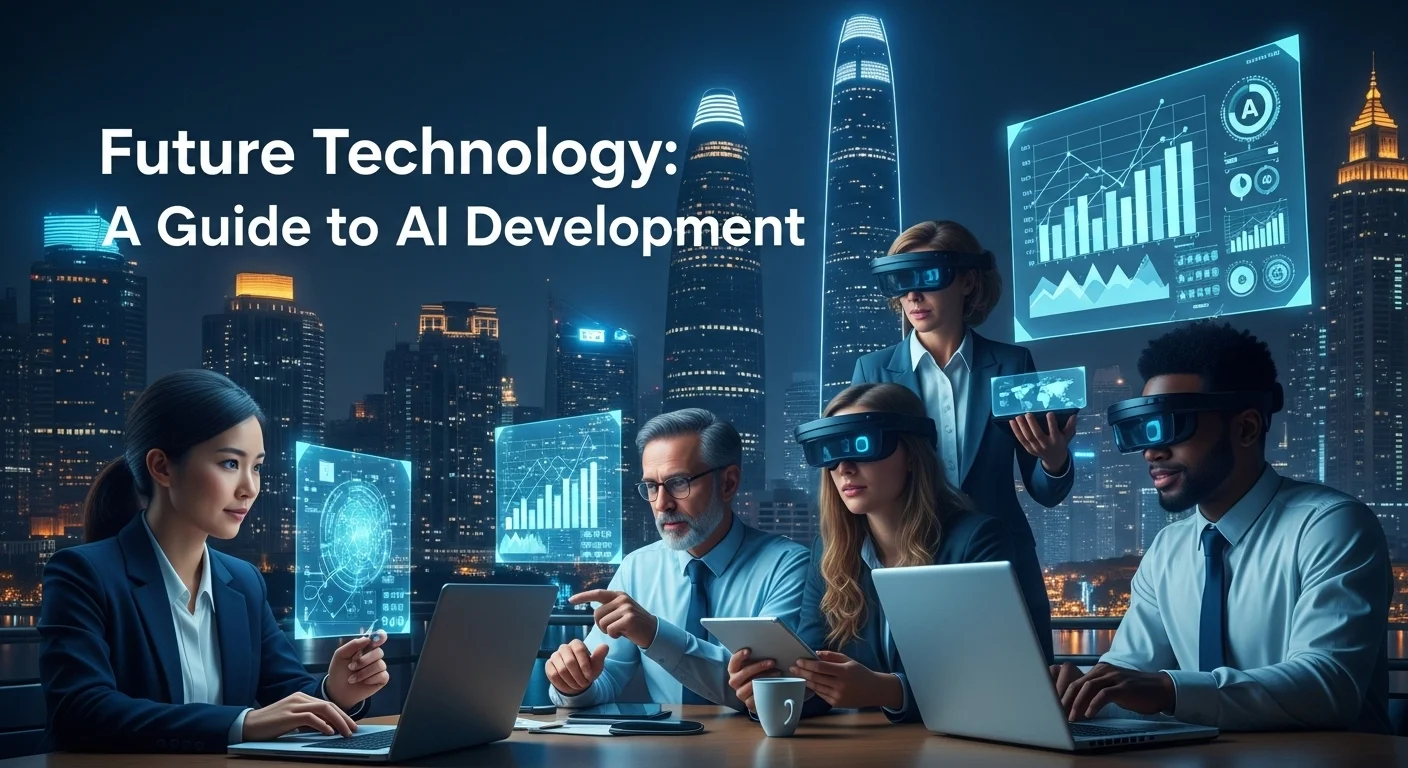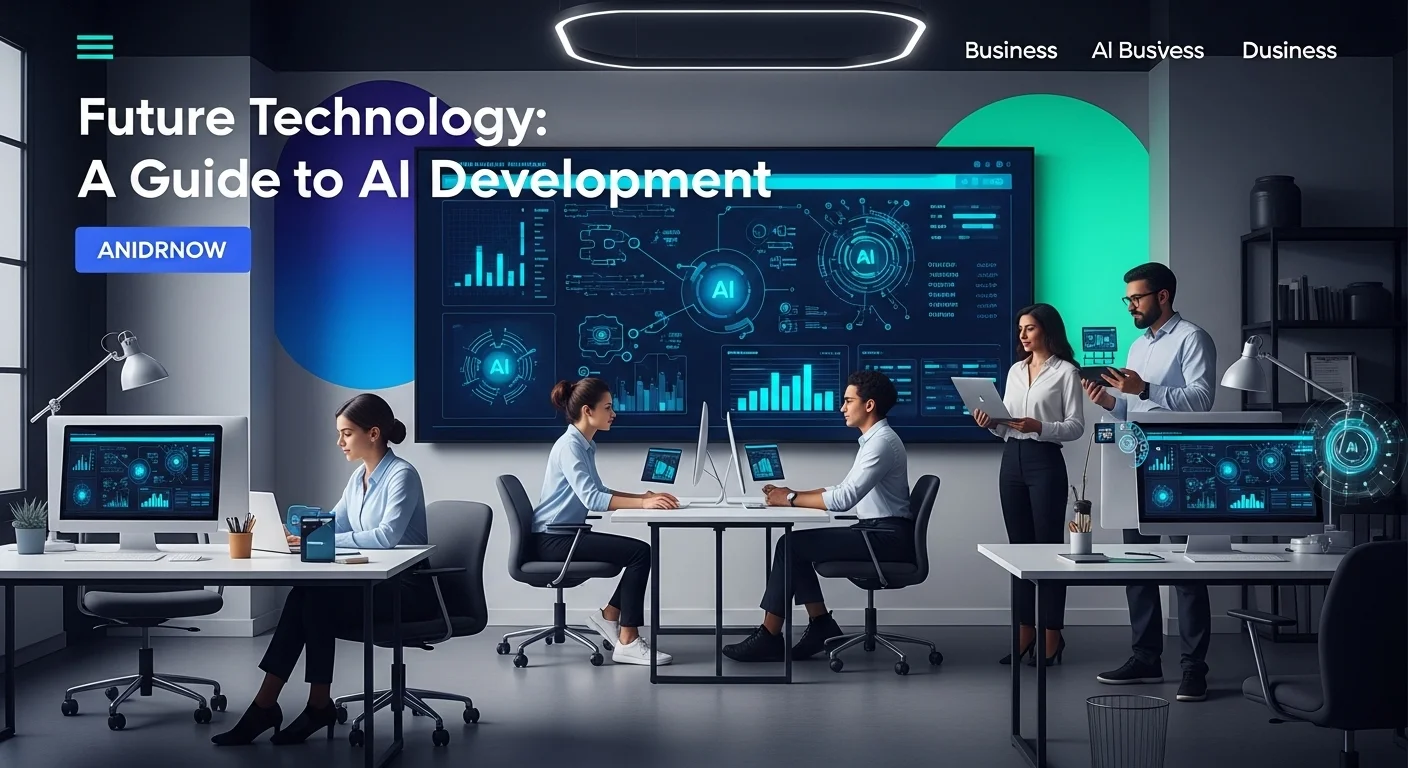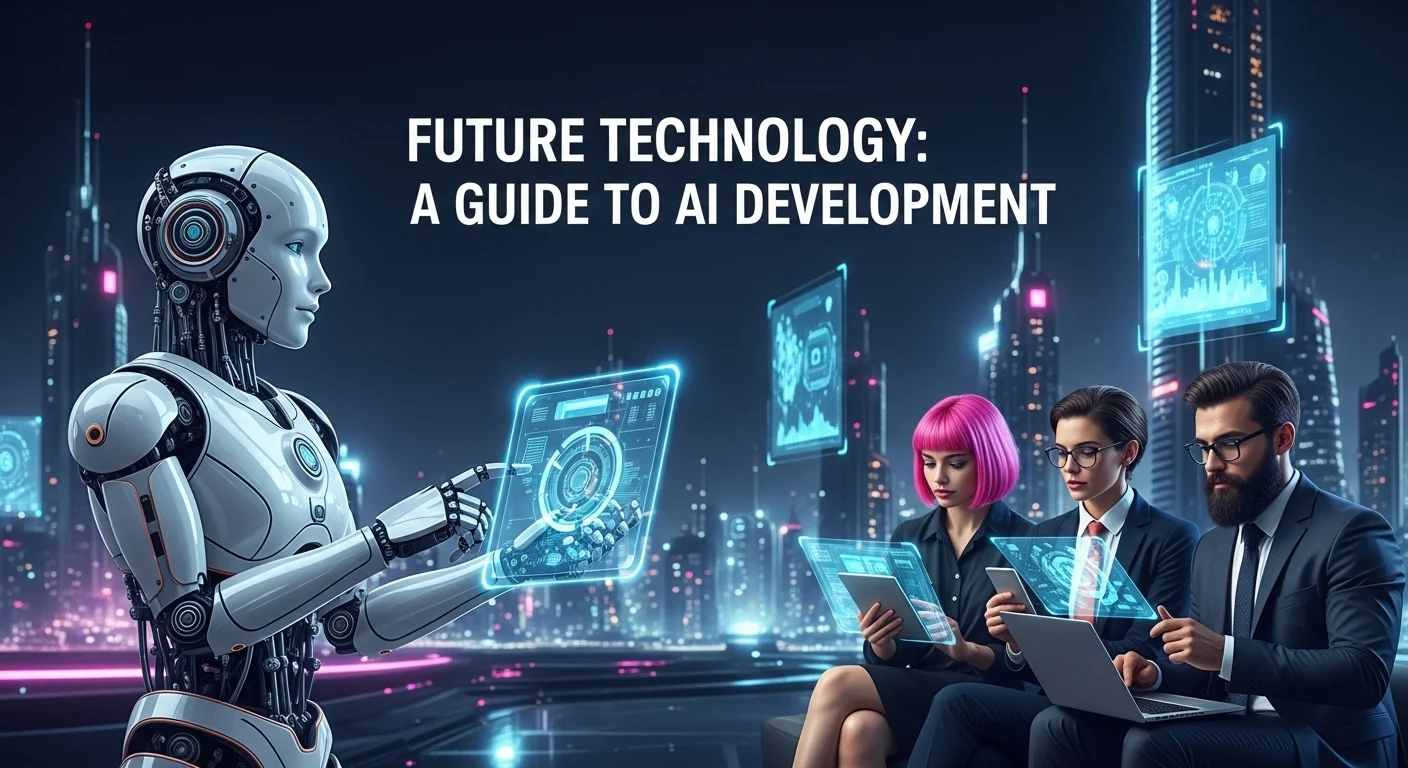AI Development Explained: A Human-Friendly Guide to a Tech Revolution

Executive Summary
Let's talk about Artificial Intelligence, or AI. It sounds like something from a sci-fi movie, but I've spent years working in this field, and I can tell you it's one of the most practical and powerful tools available to businesses today. AI isn't about robots taking over; it's about making our work smarter, our decisions sharper, and our customer experiences better. In this guide, I'll walk you through the world of AI development without the complex jargon. We'll cover what it really is, how AI development companies bring these ideas to life, and how you can start thinking about using this incredible technology to innovate and grow your own business. Think of this as a conversation, where I share what I've learned to help you navigate the future.
Table of Contents
Table of Contents
What is AI Development and Why Does It Matter in Technology?
When I first got into technology, AI was a niche, almost academic pursuit. Now, it's at the heart of everything. So, what is AI development when you strip away the hype? In simple terms, it's the craft of building computer systems that can perform tasks that normally require human intelligence. We're talking about learning from experience, solving problems, and understanding language. It’s not just about writing code that follows strict commands; it's about creating algorithms that allow a machine to learn, adapt, and make its own decisions. The progress has been incredible, moving from old theories to real-world applications that are changing our lives, powered by faster computers and vast amounts of data.
The importance of AI development in technology today is immense. It marks a huge leap from tools that just do what they're told to partners that can enhance our own abilities. AI is the engine powering innovation in almost every industry I've worked with. From predicting security threats before they happen to making supply chains more efficient, AI is a foundational piece of modern tech. It unlocks a level of automation and efficiency that we could only dream of a decade ago, freeing us up to focus on creative and strategic work. For example, AI tools can now help engineers write and debug code, which speeds up the whole development process. Believe me, AI isn't just a trend; it's fundamentally reshaping what's possible and leading to smarter, more intuitive technology.
The Core Components of AI Development
To really get a handle on AI development, you need to know about its main ingredients. These are the tools of the trade that AI development companies use to build incredible solutions.
Machine Learning (ML): This is the superstar of the AI world right now. ML is all about creating algorithms that let computers learn from data. Instead of programming every single step, you 'train' a model on a large dataset, and it learns the patterns itself. There are three main flavors:
- Supervised Learning: You give the algorithm data that's already labeled with the right answers. It's like teaching a child to identify cats by showing them pictures of cats. This is great for things like spam filters and image recognition.
- Unsupervised Learning: Here, the algorithm gets unlabeled data and has to find patterns on its own. A common use case I've seen is segmenting customers based on their buying habits without any pre-existing categories.
- Reinforcement Learning: This is about learning through trial and error. The AI interacts with an environment and gets rewards or penalties for its actions, learning the best strategy over time.
Deep Learning: This is a more advanced type of Machine Learning that uses 'neural networks' with many layers, inspired by the human brain. These 'deep' networks are fantastic at finding complex patterns in massive datasets. Deep Learning is the magic behind voice assistants like Siri, real-time translation apps, and the technology in self-driving cars. Any serious AI app development company has a team that lives and breathes Deep Learning.
Natural Language Processing (NLP): NLP is what allows computers to understand and respond in human language. It's an incredibly tough field because our language is full of nuance and ambiguity. Every time you use a chatbot, see a sentiment analysis on social media, or use a translation service, you're seeing NLP at work. Making this interaction feel natural has been a huge goal for companies that develop AI.
Computer Vision: This field trains computers to see and understand the world through images and videos. Using deep learning, these systems can recognize faces, identify objects, and understand a scene. The applications are everywhere, from analyzing medical scans in hospitals to ensuring quality on a factory assembly line.
Business Applications and Benefits of AI Development
The real magic of AI happens when it's applied to solve business problems. Companies everywhere are using AI development to work smarter, thrill their customers, and fuel growth. Partnering with AI software development companies is often the strategic key to unlocking these benefits.
A huge win is improved operational efficiency. I've seen AI completely transform workflows by automating repetitive tasks like data entry and basic customer support. This doesn't just cut down on errors; it lets employees focus on bigger, more creative problems. In manufacturing, for instance, AI-driven robots work with incredible precision, and predictive algorithms can tell you when a machine needs maintenance before it breaks down, saving a fortune.
Another game-changer is data-driven decision-making. Businesses are swimming in data, but it's useless without insights. AI can analyze massive datasets in minutes, spotting trends and anomalies a human team could never catch. This allows businesses to make smarter decisions, from fine-tuning marketing campaigns to detecting financial fraud in real-time.
Personalization and Customer Experience have been turned upside down by AI. Think of Amazon recommending products you actually want or Netflix suggesting your next binge-watch. That's AI learning your preferences. AI-powered chatbots provide 24/7 support, giving customers instant answers. This kind of personalized attention builds incredible loyalty. Many businesses seek out an AI app development company just to build these kinds of powerful customer tools.
Finally, AI development is sparking true innovation. Companies aren't just improving old processes; they're creating entirely new products and services. In healthcare, AI is helping to spot diseases earlier than ever before. In the auto industry, the dream of a self-driving car is completely dependent on AI. These breakthroughs often come from partnerships with specialized AI development companies that have the deep expertise to turn ambitious ideas into reality. The landscape of companies that develop AI is broad, from giants like Google and Microsoft to agile startups. Choosing the right one is key, as the right partner will help you apply AI in a way that creates real, tangible value.

Complete guide to AI Development in Technology and Business Solutions
Jumping into an AI development project can feel overwhelming, but with a clear roadmap, it's a manageable and exciting journey. This guide is my attempt to give you that roadmap, breaking down the process from a simple idea to a fully functioning solution. This is for the business leaders and tech folks who want to use AI smartly, whether that means building your own team or working with expert AI development companies.
The AI Development Lifecycle: A Step-by-Step Process
Every successful AI project I've been a part of follows a structured cycle. It's an iterative process that keeps the project on track and aligned with what the business actually needs. Any professional AI software development company lives by these steps.
1. Scoping and Problem Definition: This is the most important step, and one that's too often rushed. You must clearly define the business problem you want to solve. What's the goal? How will you measure success? I can't tell you how many projects I've seen stumble because they started with a cool technology instead of a clear business problem. This phase is all about collaboration. For example, instead of a vague goal like 'improve customer service,' a great problem definition is 'reduce customer call wait times by 30% by using an AI chatbot for common questions.'
2. Data Acquisition and Preparation: AI runs on data. Good, clean, relevant data is the fuel for your project. This phase involves finding your data sources, gathering the data, and then cleaning it up. Honestly, this can be the most time-consuming part. It involves:
- Data Cleaning: Fixing errors, filling in missing values, and removing duplicates.
- Data Transformation: Getting all your data into a consistent format.
- Feature Engineering: Picking the most important variables from your data that will help the AI model make good predictions.
- Data Labeling: For supervised learning, this means tagging your data with the correct outcomes.
Remember the old saying: garbage in, garbage out. It has never been truer than in AI.
3. Model Design and Development: Now for the fun part: building the actual AI model. This is where data scientists choose the right algorithm for the job, whether it's a simple decision tree or a complex neural network. They'll often experiment with a few different models to see which one works best. This is also where we pick our tools. Python is the king of AI development because of its amazing libraries and frameworks like:
- TensorFlow: Google's powerful framework for large-scale projects.
- PyTorch: Facebook's offering, loved for its flexibility, especially in research.
- Scikit-learn: A fantastic library for more traditional machine learning tasks.
A skilled AI app development company will have experts who know which tool is right for your specific challenge.
4. Model Training and Evaluation: Once designed, the model needs to be trained on your data. We typically split the data into a training set (to teach the model), a validation set (to tweak it), and a testing set (to see how it performs on new, unseen data). We then measure its performance with metrics like accuracy and precision. It's a cycle of train, test, and refine until the model is hitting its targets.
5. Deployment and Integration: A great model is useless if it's just sitting on a developer's laptop. Deployment is the process of putting the model into a live environment where it can start doing its job. This requires a close partnership between data scientists and software engineers (often called MLOps engineers) to make sure the model is fast, secure, and can handle real-world traffic. This is a core service offered by companies that develop AI.
6. Monitoring and Maintenance: The work isn't done after launch. The real world changes, and a model's performance can decline over time—we call this 'model drift.' You need to constantly monitor your model's performance to catch this. This often means retraining the model with fresh data to keep it sharp and relevant. This is a long-term commitment that's essential for success.
Business Techniques for AI Implementation
Getting AI into your business is more than just a tech project; it's a strategic move.
Build vs. Buy: This is a big decision. Do you build a custom solution yourself or buy one off the shelf?
- Building In-House: Gives you a perfect fit and full control, but it's expensive and requires hiring a specialized team.
- Hiring an Expert Firm: Working with AI development companies is often faster and more cost-effective. They bring deep expertise and have done this many times before. This is the path most companies take.
- Buying Off-the-Shelf: Many software tools now include AI features. This is the fastest option but offers the least customization.
Fostering an AI-Ready Culture: AI changes how people work. It's vital to create a company culture that embraces data and is open to learning. This means training your team and getting leaders to champion the change.
Ethical Considerations: With great power comes great responsibility. Businesses must think about fairness, bias, and privacy. An AI trained on biased data can make biased decisions. That's why Explainable AI (XAI), which makes model decisions understandable to humans, is so important for building trust. Reputable companies that develop AI take ethics very seriously.

Tips and Strategies for AI Development to Improve Your Technology Experience
To really succeed with AI development, you need more than just technical skill; you need a smart strategy and a commitment to doing things the right way. Whether you're just starting out or scaling up, these are the tips and strategies I've seen make the difference between a high-impact project and a frustrating one.
Best Practices for High-Impact AI Development
Following a few key best practices can make your AI journey smoother and more successful. These are the rules I try to live by on every project.
1. Start with a Clear Business Case: I've said it before, but it's worth repeating. Every AI project must solve a real problem and have a clear, measurable goal. Avoid the temptation to chase shiny new tech. A strong business case gives your project direction and a way to prove its value. The best AI development companies I know will insist on this clarity before writing a single line of code.
2. Prioritize Data Quality and Governance: Your AI is only as good as your data. From day one, you need a solid plan for how you collect, store, and secure your data. Make sure it's clean, relevant, and as unbiased as possible. This isn't a one-time task; it's an ongoing commitment to responsible AI development.
3. Embrace an Iterative, Agile Approach: AI development is a process of discovery. It's not a straight line. I always recommend an agile approach that allows for quick experiments, testing, and learning. Start small with a Minimum Viable Product (MVP) to test your idea before going all-in. This is standard practice for any modern AI software development company because it's flexible and lowers risk.
4. Focus on Explainability and Trust: People won't use AI if they don't trust it, especially in critical fields like finance or healthcare. Look into Explainable AI (XAI) techniques that make a model's decisions transparent. This helps with debugging, but more importantly, it builds trust with everyone who uses the system.
5. Plan for Security and Privacy from Day One: AI systems have unique security risks, like attacks designed to fool a model. Privacy is also a huge concern. Security can't be an afterthought; it has to be part of the entire development process. This means things like data encryption and complying with privacy laws like GDPR.
6. Monitor and Maintain Models Post-Deployment: An AI model is a dynamic system that needs care. You need to monitor its performance in the real world to catch 'model drift.' Plan to retrain your model with new data periodically to keep it effective. This continuous process, known as MLOps, is what separates the pros from the amateurs among companies that develop AI.
Choosing the Right AI Development Partner
For most businesses, finding the right external partner is the fastest way to get access to top AI talent. But choosing that partner is a huge decision.
1. Evaluate Technical Expertise and Industry Experience: Don't just believe the marketing hype. Ask for case studies and client references that are relevant to your industry. Do they have real expertise in the specific AI techniques you need, like NLP or computer vision? A top-tier AI app development company will be proud to show you their portfolio.
2. Assess Their Approach to Problem-Solving: A great partner is a strategic advisor, not just a coder. In your first conversations, they should be asking smart, tough questions to really understand your business problem. Their focus should be on delivering business value, not just technology.
3. Inquire About Their Development Process and Ethics: Ask them how they work. How do they manage projects and ensure quality? And critically, what's their framework for ethical AI? How do they tackle bias? A responsible AI development company will have clear, confident answers.
4. Understand Their Support and Maintenance Model: The relationship doesn't end at launch. What kind of ongoing support do they offer? Will they help you monitor and retrain the model? A long-term partner is almost always more valuable than a one-off project contractor.
Future Trends in AI Development
The world of AI moves fast. Keeping an eye on what's next is key for long-term planning.
Generative AI: This is the trend everyone is talking about. Models like GPT-4 can create brand new content—text, images, code, you name it. Think of it like an incredibly creative assistant. Businesses are already using it for everything from content creation to drug discovery. Its capabilities are only going to grow.
Multimodal AI: The next wave of AI will be able to understand information from multiple sources at once, like text, images, and sound. This leads to a much deeper understanding of context and more capable AI assistants that can, for example, analyze a chart in a report while listening to your voice commands.
AI at the Edge: This means running AI models directly on devices like your phone or a smart sensor, instead of in the cloud. This is faster, more private, and works without an internet connection. It's essential for things like self-driving cars and smart factories.
AI Regulation and Governance: As AI becomes more common, governments are starting to create rules for its use. It's crucial to stay on top of these evolving laws. Working with a knowledgeable AI software development company can help you navigate this complex landscape responsibly.
By following these practices, choosing your partners wisely, and looking to the future, you can truly unlock the power of AI development. The goal is to build technology that's not just smart, but also responsible, trustworthy, and good for business.
Expert Reviews & Testimonials
Sarah Johnson, Business Owner ⭐⭐⭐
The information about AI Development is solid, but as a business owner, I'd love to see more real-world case studies for smaller companies like mine.
Mike Chen, IT Consultant ⭐⭐⭐⭐
A great overview of AI development. It clarified a lot for me, though some of the more technical bits could be broken down even further for consultants who aren't deep in the code every day.
Emma Davis, Tech Expert ⭐⭐⭐⭐⭐
Fantastic article! As a tech specialist, I found it comprehensive and spot-on. It's a great resource that connects the dots between theory and practice. Perfectly explained.



